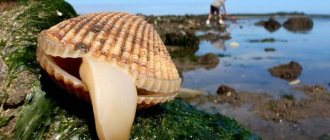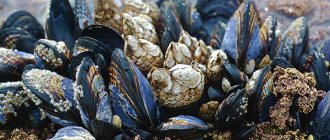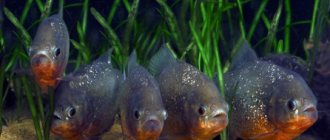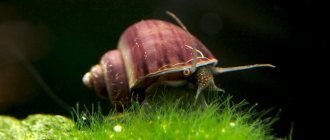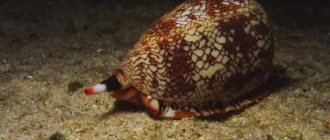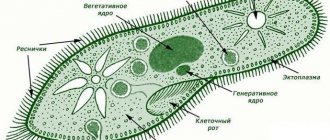Laboratory work External structure of shells of freshwater and marine mollusks
Purpose: To establish the similarities and differences in the structure of mollusk shells.
Equipment and materials: tweezers, shells of mollusks: scallop, mussels, barley, toothless, horny coil, large pond snail and others.
Progress:
- We look at scallop and mussel shells. Let's find out their similarities and differences. The similarity is that both shells are hard to the touch and dense. Both have bilateral symmetry of the shells, their posterior parts with slight roughness and depressions. Difference between scallop and mussel shells in different colors and shapes. We can see that the scallop shell does not have the growth rings that the mussel shell has. The recesses and protrusions on the dorsal side of both shells are formed by the environmental conditions where the mollusks are located, namely, uneven terrain.
- We look at pearl barley and toothless shells. We find the front (wide) and rear (narrow) ends in them. We pay attention to the similarities and differences between the shells. The shell of the river barley is oblong in shape, gradually tapering towards the rear end. Its valves are strong and thick, with a well-developed mother-of-pearl layer. At the junction of the valves there is a complex “lock” in the form of teeth, which fit into the corresponding recesses. Thanks to this, the doors are compressed as tightly as possible and cannot move in different directions relative to each other. The toothless shell is round, flat, with thin walls. It does not have teeth at the junction of the valves, like pearl barley, so it is closed less tightly.
Determine the color of the outer layer of shells. We scrape off part of the outer layer with tweezers and examine the layer of calcium carbonate located underneath it. Let's look at the inner pearlescent layer. We see that the shell of the pearl barley is light brown, while the toothless shell is yellow-gray. Each of them consists of three layers. The first layer is formed by conchiolin. Under it there is a second layer - porcelain and the first layer - mother-of-pearl. The last two layers consist of calcium carbonate crystals. It is precisely the thin plates of the last - mother-of-pearl layer - that allow us to see that same pearlescent shine when light rays are reflected.
- We look at the shells of a large pond snail and a horned reel. Both representatives have a solid shell, which is curled into a spiral. In the pond snail this is more pronounced. Its shell is spirally twisted, has four turns, ends with a sharp tip and reaches 50 mm in length and 35 mm in width. Consists of calcium carbonate. On top there is a layer of horn-like substance. Its dimensions are 50 mm in length and 35 mm in width. On the opposite side of the sharp edge there is a wide hole or mouth through which the leg or head of the mollusk protrudes.
The horn coil has a disc-shaped shell. Its height is 1 cm, and its diameter is 6 cm. There are only 3 curls.
- Looking at the tops of the shells, you can see layers of annual growth. The number of these layers indicates the age of the mollusks, since as it grows, the shell also grows. For example, the age of the toothless one is 15 years, the pearl barley is 10 years old, and the pond snail is 12 years old
- Mollusk shells form 1 organic layer and 2 calcareous ones. The body of bivalves consists of two shells. Moreover, many of them are similar to each other, for example, toothless and pearl barley in their general structure. However, by paying attention to such details as teeth on the valves, surface roughness, number of rings, type of curl, we can easily determine what kind of mollusk we have in front of us.
Reproduction and development
Toothless are dioecious, but hermaphrodites are also found. Males and females cannot be distinguished externally.
Reproduction
Males release sperm into the water through the excretory siphon. Together with water, they enter the body of females through the entrance siphon and then fertilize the eggs located there. Developing embryos are located on the gills of females throughout autumn and winter. To do this, special ventilation tubes appear in the gills, which improve gas exchange.
Life cycle
Toothless larvae are called glochidia:
In spring, they emerge from the mother's shell through the upper siphon. Their valves have large hooks with teeth and an adhesive thread, with which they are secured to the skin of fish swimming past them. A tumor appears there, in which glochidia develops, parasitizing the fish. The grown mollusk breaks through the skin of the fish and descends to the bottom, as you can see in the picture:
This development cycle favors the wide distribution of these mollusks.
Nutrition
In a living, undisturbed toothless, the valves in the rear part are slightly open and two small openings are visible - siphons (Fig. 61). They lead into the mantle cavity. The gills and the inner sides of the mantle folds are covered with cilia. They move continuously and draw water through the lower siphon. Water passes throughout the mantle cavity and exits through the upper siphon. Along with the water, various small organisms living in it are brought in - protozoa, crustaceans. A current of water carries them to the mouth, located near the base of the leg, and from the mouth they then enter the digestive system.
| Rice. 61. Digestive, arterial, circulatory, and nervous systems are toothless |
Where do toothless people live?
In our reservoirs you can most often find the common toothless fish, whose body length is 20 centimeters. They live in Western Siberia and the European part of our country. The habitat of these mollusks with a fragile shell is lakes, ponds and river backwaters.
This species is very variable; in one body of water, various forms and varieties of toothless can be found. Some of them are so non-standard that they are classified as new subspecies or new species.
In the rivers of the European part of our country there is also a narrow toothless fish, which has an elongated and compressed shell. These mollusks even live in desalinated areas of the seas; for example, they are found in the Caspian Sea in the Volga delta.
The Caucasian toothless fish lives in the rivers and lakes of the Caucasus with clear fresh water. The largest representatives of the species live in the Far East, in the Primorsky Territory. These mollusks are called Wood's toothless mollusks; they have a highly swollen shell, the length of which reaches 15 centimeters. There are also vaulted toothless ones that grow up to 10 centimeters in length.
Conditions at home
If the mollusk is kept at home, then it is very sensitive to the water in the aquarium. If the toothless is in a terrarium, then chemicals cannot be added to the water, otherwise the animal will immediately die from this. The mollusk also likes to have a large amount of dissolved oxygen in the water. Algae must grow in the terrarium, and you also need to put a special device in the water that will create forced aeration.
The body of the mollusk contains a lot of iodine, zinc and other necessary elements for the full development of fish. Usually, the shellfish is crushed before serving to the fish. If you keep a toothless pet as a pet, then with proper care it can live for more than 2 years.
When moving in an artificial reservoir, the mollusk plows up the sand, which can damage plants if they have a weak root system. The way out of the situation is to plant algae in special pots. The optimal water temperature for clams is 20 or 25 degrees Celsius. Before placing a mollusk in an artificial reservoir, it must be kept in quarantine and acclimatized to an unknown environment. It does not matter where the animal was purchased: in a pet store, raised in an aquarium, or caught in a natural reservoir.
It must be quarantined for 12 hours, after which aquarium water is added to a separate container in small quantities. The adaptation period is 8 days. At this time, the water should be well aerated. If the toothless fish is located in an artificial reservoir, then its condition must be constantly monitored. A dead snail can be recognized by its shell flaps wide open. It is not recommended to place river mollusks in an artificial reservoir, because they will have a difficult adaptation period. In addition, river mollusks will not live long in captivity.
Benefits and harms
Toothless fish are tightly integrated into the ecosystem of fresh water bodies.
Role in nature
In nature they play an important role. By filtering water, they prevent it from stagnation and blooming. In addition, they cleanse it of microbes that cause fish diseases. Young mollusks, which have thin shell flaps, are readily eaten by a lot of animals: geese, ducks, fish, muskrats, muskrats and others.
What harm does it cause?
Toothless larvae parasitize fish. They can cause wounds that cause infections, which can lead to the death of animals.
Economic importance
The significance of toothlessness in economics is less significant. These mollusks are used in the following capacities:
- their meat is used as a protein additive in pet food; it spoils quickly, but in solving this problem this direction is very promising, since the meat is very high in calories, and the shellfish themselves multiply quickly;
- crushed crumbs from their shells are added to chicken feed;
- in some countries it serves as a raw material for the production of lime;
- mother-of-pearl buttons are made from shells;
- Toothless is often used as a bioindicator species in environmental studies.
Toothless mussels are larger and may taste better than mussels, but they cannot be used as food. These are filter feeders that carry helminths and diseases dangerous to humans. You can only eat marine shellfish - oysters and mussels.
Human use
Since ancient times, many varieties of bivalves have been used by humans for various purposes.
- Their meat is considered a delicacy; it has excellent taste, is healthy and is easily digested by the body. It contains large quantities of vitamins A, B, C, D. Bivalve meat is rich in iron, iodine, copper, zinc and other minerals.
- In many countries, over the past few decades, mollusks have begun to be relocated to new territories, assisting in acclimatization. Artificial breeding is also practiced in the seas, freshwater and artificially created reservoirs. Also, for breeding bivalves, shallows and small bays are used, which are specially prepared for this purpose and protected from predatory inhabitants.
- Bivalve ones have found use in the form of popular souvenirs and decorations. Pearls are used in jewelry production, and inexpensive jewelry and buttons are made from mother-of-pearl extracted from shells.
- Shells are often used as a decorative element, pressed into plates that are used to decorate walls, paths in gardens and photo frames.
Interesting fact! Among the Indians, pieces of shells served as a currency. Shells were also used to make utensils and fishhooks.
- Shellfish inhabiting polluted water bodies are capable of accumulating pollutants of organic origin and heavy metals. Therefore, they are used as a biological indicator of environmental pollution.
- Often, bivalves are used by humans to purify water.
- Some species of mollusks produce byssus, which is used in the textile industry. It is one of the components for the production of fine linen, an expensive type of fabric.
- Bivalves are considered the most valuable and popular food for fish, so reservoirs in which mollusks are found are used as places for fattening commercial fish species.
- A food supplement made from crushed shells is used to feed poultry.
- In agriculture in a number of countries, their shells are used in the production of lime.
Attention! There are poisonous species of bivalves that can cause paralysis, long-term neurological disorders and even death in humans. Raw and improperly prepared shellfish can cause infections in the human body. Therefore, it is better to prepare this delicacy with caution.
Lifestyle
Marine bivalves are typical bottom-dwelling animals that often burrow into the sand. They often form large accumulations on the seabed (mussels, oysters, etc.). The largest of the bivalves reach a mass of more than 250 kg, and their shell can be 1.5 m or more in length.
Some bivalves can burrow into wood (shipworm) and stone, causing great damage to the wooden hulls of ships and coastal structures in seaports.
Many bivalves are of practical importance. Pearls and mother-of-pearl are obtained from them; oysters, mussels, scallops, etc. are used as food.
Please rate the article. We tried our best:)
Surface of mollusk shells
Surface of mollusk shells
The surface of the shell of freshwater mollusks is mostly smooth, but sometimes, for example, in species of the genus Planorbis, Pisidium, Sphaerium , it has microsculpture in the form of transverse or longitudinal stripes, spines, ribs, etc. These morphological details are best distinguished in early spring, while the shell has not yet had time to become overgrown with algae.
